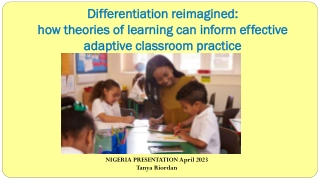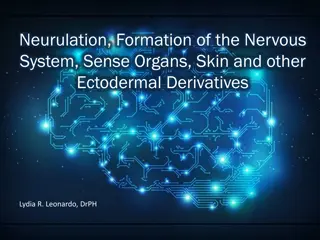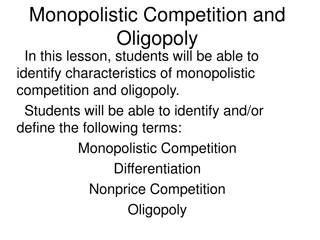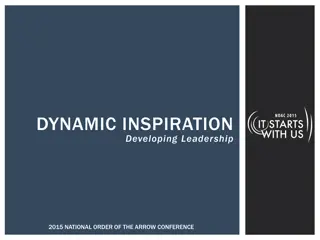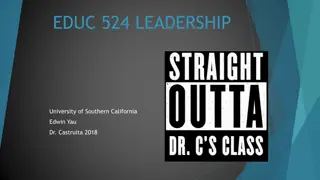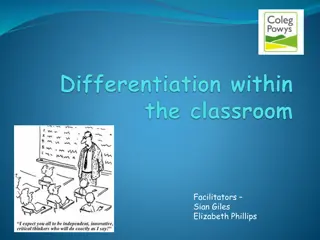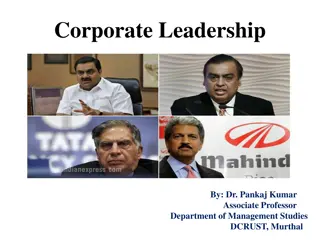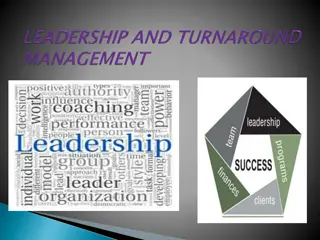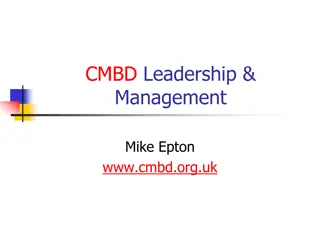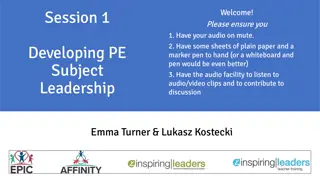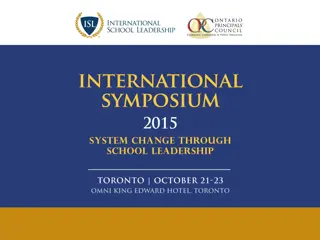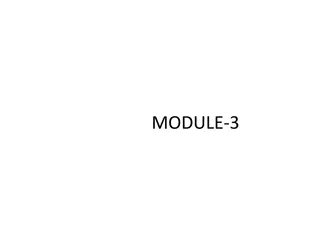Understanding Leadership: Key Concepts and Differentiation
Leadership, as explained by Ronald Heifetz, goes beyond personal traits and authority. It involves problem-solving and capacity-building in a dynamic world. The distinction between leadership and authority is crucial, emphasizing leadership as a practice rather than a set of inherent characteristics. By distinguishing between leadership and authority, we can better guide individuals in leading with or without formal power, encouraging a broader participation in effective leadership practices.
Download Presentation

Please find below an Image/Link to download the presentation.
The content on the website is provided AS IS for your information and personal use only. It may not be sold, licensed, or shared on other websites without obtaining consent from the author. Download presentation by click this link. If you encounter any issues during the download, it is possible that the publisher has removed the file from their server.
E N D
Presentation Transcript
Leadership: The Adaptive Framework University of Alaska June 2017 Ronald Heifetz ronald_heifetz@harvard.edu
Where are We: In the Development of Leadership as an Area of Study? ronald_heifetz@harvard.edu
How Should We Define Leadership? Leadership is not defined by: The inputs of personal capacity, or The instruments of authoritative power, and influence Leadership is defined by: The work that is needed to solve tough problems and build capacity to thrive in a changing and challenging world. ronald_heifetz@harvard.edu
Three Common Confusions of Leadership 1. Leadership = personal characteristics 2. Leadership = authority and influence 3. Leadership = value-free ronald_heifetz@harvard.edu
We Confuse Leadership with Traits of Social Dominance ronald_heifetz@harvard.edu
Social Dominance: Nature and Nurture Social dominance tendencies in children are partly natural But social dominance does not usually determine who will gain adult authority And authority does not determine leadership ronald_heifetz@harvard.edu
Leadership is better viewed as a practice, and not a set of personal characteristics ronald_heifetz@harvard.edu
Distinguish Leadership from Formal and Informal Authority ronald_heifetz@harvard.edu
Three Benefits to Distinguishing Leadership from Authority We can study and guide the practice of: 1. Leadership with Varying Kinds of Authority 2. Leadership without Authority We can encourage anyone to lead 3. The Practices of Authority ronald_heifetz@harvard.edu
Properties of Authority A service contract Party A entrusts power to Party Bfor services Formal or informal Key components of the contract Power Trust Service ronald_heifetz@harvard.edu
Authority Relationships Power Entrusted B A Service ronald_heifetz@harvard.edu
Key Services of Authority Direction Protection Order Orientation to roles Control of conflict Norm maintenance ronald_heifetz@harvard.edu
Trust Predictability Values Competence ronald_heifetz@harvard.edu
The Paradox of Trust People will trust you when you fulfill their expectations for service So what happens when you: Deliver information that conflicts with those expectations? Tell people what they may need to hear, but not what they want and expect to hear? ronald_heifetz@harvard.edu
The Work of Leadership ronald_heifetz@harvard.edu
View I Power Authority Informal Authority Formal Authority -Neustadt s Power -Nye s Soft Power -Neustadt s Powers -Nye s Hard Power a Management and Leadership Coercion Influence ronald_heifetz@harvard.edu
View 2 Power Authority Informal Authority Formal Authority -Neustadt s Power -Nye s Soft Power -Neustadt s Powers -Nye s Hard Power Management and Leadership Coercion Influence ronald_heifetz@harvard.edu
View 3 Work Authority Formal and Informal Authority -Neustadt s Powers and Influence -Nye s Hard and Soft Power Management Leadership Adaptive Technical ronald_heifetz@harvard.edu
Distinguish Technical and Adaptive Work ronald_heifetz@harvard.edu
Technical and Adaptive Work PRIMARY LOCUS OF RESPONSIBILITY FOR THE WORK PROBLEM DEFINITION SOLUTIONS & IMPLEMENTATION KIND OF WORK TECHNICAL CLEAR CLEAR AUTHORITY AUTHORITY & STAKEHOLDER TECHNICAL & ADAPTIVE CLEAR REQUIRES LEARNING ADAPTIVE REQUIRES LEARNING REQUIRES LEARNING STAKEHOLDER > AUTHORITY ronald_heifetz@harvard.edu
Common Mistake We treat adaptive challenges as technical problems We do this for both political and personal reasons ronald_heifetz@harvard.edu
Essential Questions of Adaptive Work 1. What cultural DNA do we keep? 2. What cultural DNA do we discard? 3. What innovative DNA will enable us to thrive in the new and challenging environment? ronald_heifetz@harvard.edu
Sustainable Transformative Change is Adaptive Cultural DNA Conserved Lost New ronald_heifetz@harvard.edu
Key Properties of Adaptive Work 1. Adaptive work demands responses outside the current repertoire. 2. Adaptive organizations are interdependent with their environment. 3. Sustainable success requires local adaptations to local environments. 4. Adaptive solutions are conservative as well as innovative. 5. The people with the problem are the problem, and the solution. ronald_heifetz@harvard.edu
Key Properties of Adaptive Work 6. Adaptive solutions often lie within the society or organization. 7. Innovation toward adaptive change is experimental. 8. Solutions involve direct loss and indirect loss as people re-fashion loyalties and develop new competencies. 9. Adaptive work generates disequilibrium and avoidance because losses generate resistance. 10. Adaptive work takes more time than technical work. ronald_heifetz@harvard.edu
Technical and Adaptive Work LIMIT OF TOLERANCE PRODUCTIVE RANGE OF STRESS THRESHOLD OF LEARNING WORK AVOIDANCE ADAPTIVE CHALLENGE TECHNICAL PROBLEM TIME ronald_heifetz@harvard.edu
Avoiding Adaptive Work To avoid real and potential losses By diverting responsibility or attention ronald_heifetz@harvard.edu
Displace Responsibility 1. Look for a Big Man to fix the problem 2. Externalize the enemy 3. Attack authority 4. Divide the top team 5. Kill the messenger 6. Scapegoat ronald_heifetz@harvard.edu
Divert Attention Partial or Fake Remedies Define the problem to fit our competence Define the problem to make it somebody else s Misuse structural adjustments Misuse consultants, committees, task forces 1. Deflect attention to side issues, irrelevant issues 2. Deny 3. Lie 4. ronald_heifetz@harvard.edu
Defining Leadership Leadership is a practice with and without authority that mobilizes people and builds capacity to make progress on adaptive challenges in order to thrive in a changing and challenging world ronald_heifetz@harvard.edu
Distinguish Management and Leadership ronald_heifetz@harvard.edu
Management and Leadership Management mobilizes the efficient coordination of complex technical problem-solving Leadership mobilizes adaptive work: honoring the essential, discarding the expendable, and innovating to build new capacity ronald_heifetz@harvard.edu
Operating from Authority Positions Mode of Operating Managing Leading Responsibilities Situation Technical Adaptive Direction Define problems and solutions Identify adaptive challenges and frame the key questions and issues Protection Shield the organization from external threat Let the organization feel external threats within a productive range of distress Order: Restore order Regulate disequilibrium -- within a productive range Orientation Clarify roles and responsibilities Disorient current roles and resist pressure to orient people to new roles too quickly Managing Conflict Reduce conflict Surface and use conflict productively Shaping Norms Maintain current norms Challenge unproductive norms or let them be challenged ronald_heifetz@harvard.edu
The Practice of Leadership Near-Term Mobilizing adaptive work Long-Term Building a culture of adaptability ronald_heifetz@harvard.edu
A Strategy of Leadership: Mobilizing Adaptive Work ronald_heifetz@harvard.edu
A Strategic Framework with Four Quadrants System Self/Role Diagnosis 1 2 Action 4 3 ronald_heifetz@harvard.edu
Quadrant 1: Analyzing The Work Systemically ronald_heifetz@harvard.edu
Quadrant 2: Placing Yourself in the System ronald_heifetz@harvard.edu
Quadrant 3: Managing Yourself ronald_heifetz@harvard.edu
Quadrant 4: Taking Action ronald_heifetz@harvard.edu
Quadrant 1: Analyzing The Work Systemically ronald_heifetz@harvard.edu
Eight Strategic Tasks Diagnosis Get on the Balcony Diagnose the Adaptive Challenges Action Keep Attention Disciplined Give the Work Back to People Build Trust Regulate Stress Generate More Leadership Infuse the Work with Meaning 1. 2. 1. 2. 3. 4. 5. 6. ronald_heifetz@harvard.edu
Get on the Balcony Take an interpretive stance Think politically Zoom in and out iteratively, macro and micro Consider the larger arc of change Take time for reflection Use partners Reflect on your own pre-dispositions and loyalties Whose water are you carrying? ronald_heifetz@harvard.edu
Diagnose the Adaptive Challenges Unbundle Technical from Adaptive challenges Distinguish ripe from unripe issues Identify the key stakeholders and their perspectives Listen across and outside the organization Look through authority figures to their constituents Listen to the song beneath the words Use conflict as a clue Use your team dynamics as a case-in-point for clues ronald_heifetz@harvard.edu
The Politics of Leadership ADAPTIVE CHALLENGE ronald_heifetz@harvard.edu
Quadrant 2: Placing Yourself in the System ronald_heifetz@harvard.edu
Placing Yourself in the System Placement 1. Mindsets of leadership 2. Anchoring yourself 3. Purposefulness 4. Maintaining Heart 5. Distinguishing Role from Self 6. Renegotiate Loyalties that Inhibit Diagnostic Inquiry 7. Practices to Stay Alive 8. ronald_heifetz@harvard.edu
Placement You ve been entrusted with power for services. In analyzing your placement in the authorizing environment, What is your authorization, i.e., what is your job? 1. Who are the sources of your authorization? 2. What are the expectations of each of these sources of authorization? 3. What are the cultural norms -- the unwritten rules of behavior -- that 4. come with your authority? What are the limits of your authority: What does your authority enable 5. you to do? What does it not enable you to do? ronald_heifetz@harvard.edu
Anchoring Yourself in Key Mindsets of Leadership Conserve essential values and capacity Experiment pervasively Improvise responsively Scan 360 degrees for new challenges Model consistent orienting values Take losses thoughtfully ronald_heifetz@harvard.edu
Why Lead? Service The Form Doesn t Matter The Myth of Measurement ronald_heifetz@harvard.edu


